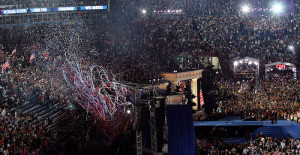Emotions are Stubborn Things, Part 1
“Facts are stubborn things; and whatever may be our wishes, our inclinations, or the dictates of our passion, they cannot alter the state of facts and evidence.”
— John Adams, ‘Argument in Defense of the Soldiers in the Boston Massacre Trials,’ December 1770

By now, as we face the final run-up to the November election, most of us have heard more than enough about the presidential horserace. Lately, though, I can’t get a certain politically embedded mantra out of my head. So, with that as my mental soundtrack, I’ll share a few thoughts on politics and communication.
“Facts are stubborn things.” Have you heard this one?


It’s one “sticky” phrase. At least three presidents, including John Adams (see above), and one former presidential candidate (who will remain nameless) have warned us about the redeeming intransigence of facts, and legions of pundits and citizen bloggers have chimed in for the chorus during the current election cycle. Google “facts are stubborn things,” and you’ll get 71,800+ results, most of which landed in cyberspace in the last two years.
So, here’s my question: Are facts the only stubborn things?
Many have invoked the mantra of factuality as a form of reproach, as a call for logic and objectivity in the face of voter behavior seemingly run amok. Yet, the most stubborn fact of all is this: Emotions are far more likely than any other force to sway voters and keep them swayed. The facts, well, they tend to be pesky and persistent but not altogether persuasive. In fact, dare I take on John Adams directly and assert that “our wishes, our inclinations, [and] …the dictates of our passion…” often effectively obscure “the state of facts and evidence?”
Ready. Set. Stay Right There!
The more I listen to the candidates — all of them — the more I realize the facts take on a mutable quality depending on how each campaign uses them to motivate the public. Any campaign is a long, grueling slog, and a lot of positional shape-shifting goes on to meet the demands of getting elected. Meanwhile supporters are often forced to reconcile a candidate’s new (or nuanced) posture with a set of nagging (and perhaps even screaming) facts about his or her previous thoughts, words and actions.
As we’ve witnessed, candidates’ positions change early and often, but even so, most of the political faithful won’t shift their loyalties based on mere factual content. A frequent response: “What else you got?” Most people lock into their candidates emotionally and then ride out the storm of all contrary information until the elections are over and done. Prying them loose from those starting blocks of emotional connection can require a Herculean effort.
“I was for it before I was against it.”
Specific examples of emotional lock-in have played themselves out ad nauseam in the media, so I won’t spend much time detailing them. Here’s one quick example since it’s topical: Obama campaigned vigorously from the outset as a reformer and agent of change, and then he recently selected Biden, a Washington institution, as his running mate. Many Obama supporters suffered cognitive dissonance in that moment but still didn’t complain that much, all things considered. Over in the other camp — because we won’t play favorites – McCain has repeatedly questioned Obama’s readiness to lead based on a thin resume, but he selected a vice presidential candidate whose experience has been questioned on similar grounds. Palin’s selection has proved hugely popular with his base.
Then, there’s always the proverbial I-was-for-it-before-I-was-against-it issue. The John Kerry quote (which is a paraphrase, actually) is an enormously popular rant by opponents but doesn’t seem to deter supporters of the candidate espousing the flip-flopped position in question. Go figure!
The emotional politics of communication
Now, while all this talk about the presidential sweepstakes is highly distracting, my larger point today is not about politics but rather communication, and politics merely offer up the rules of communication on steroids.
In Showing the White Sail, an article I recently co-authored, I emphasize, among many other things, a point well-known to marketers and advertisers: When it comes to communication, emotion often trumps content (aka facts). Voters are loyal to parties and candidates (often in exactly that order) in the same way consumers are loyal to certain brands. A beloved brand has core emotional appeal, and that’s enough to justify the purchase, or the vote, as the case may be. You’ve seen them — the people who swear by Coach bags, Apple iPods and BMW automobiles even though interchangeable and less expensive alternatives exist. These products just make them feel happy, hip, prosperous, _____________ [ you insert the desired emotional state in the blank], etc. They’re hooked.
Similarly, voters stick by their candidates because powerful emotions have been stirred up in them, whether those emotions are fear, anger, disappointment, contentment, joy or hope. People connect emotionally with candidates for any number of reasons that will displace pure logic: looks (especially good ones), physical demeanor, behavior, personality, or ideological, cultural or sexual identity. Once connected, many individuals are inclined to stay the course for decades or the duration, factual inconsistencies be damned – or at least shoved to the side.
Yes, emotions are stubborn things indeed. But even after having said all that, the stubbornness of emotions is not necessarily a bad thing. Emotions can actually help people to adapt in times of crisis, in times when facts and larger circumstances actually change, in times when a business model – much like a campaign strategy – needs to evolve to better serve constituents. But that’s the subject of Part 2 of this post, in which I’ll shift from electoral politics to the politics of communication in the workplace. Stay tuned.



Leave a Reply
Want to join the discussion?Feel free to contribute!